Analysis of the Finance of Healthcare Industry in the United States
VerifiedAdded on 2020/04/07
|9
|1722
|37
Report
AI Summary
This report provides an analysis of the finance of the healthcare industry in the United States. It begins by exploring the evolution of healthcare financing and its importance in relation to GDP growth. The report then details various payment models, including pay for coordination, pay for performance, episode-based payments, and capitation models, comparing them to models in other business sectors. It highlights the drawbacks of the fee-for-service model and the factors driving the shift towards value-based or outcome-based models. The report concludes that the adoption of these models is crucial for improving patient access, reducing costs, and enhancing the quality of care, emphasizing the distinct nature of healthcare finance compared to other industries. The report utilizes various research papers to support the analysis and findings.
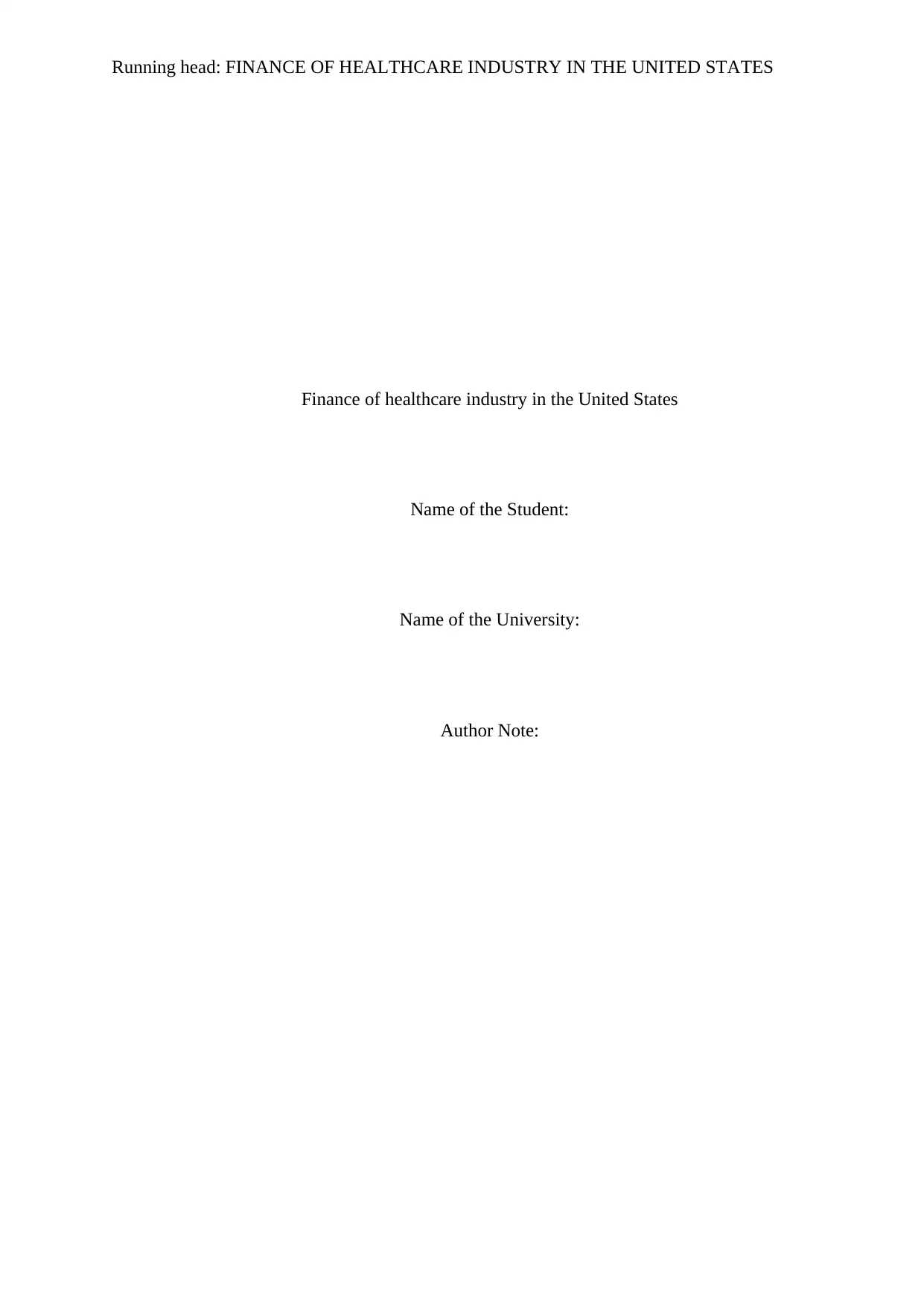
Running head: FINANCE OF HEALTHCARE INDUSTRY IN THE UNITED STATES
Finance of healthcare industry in the United States
Name of the Student:
Name of the University:
Author Note:
Finance of healthcare industry in the United States
Name of the Student:
Name of the University:
Author Note:
Paraphrase This Document
Need a fresh take? Get an instant paraphrase of this document with our AI Paraphraser
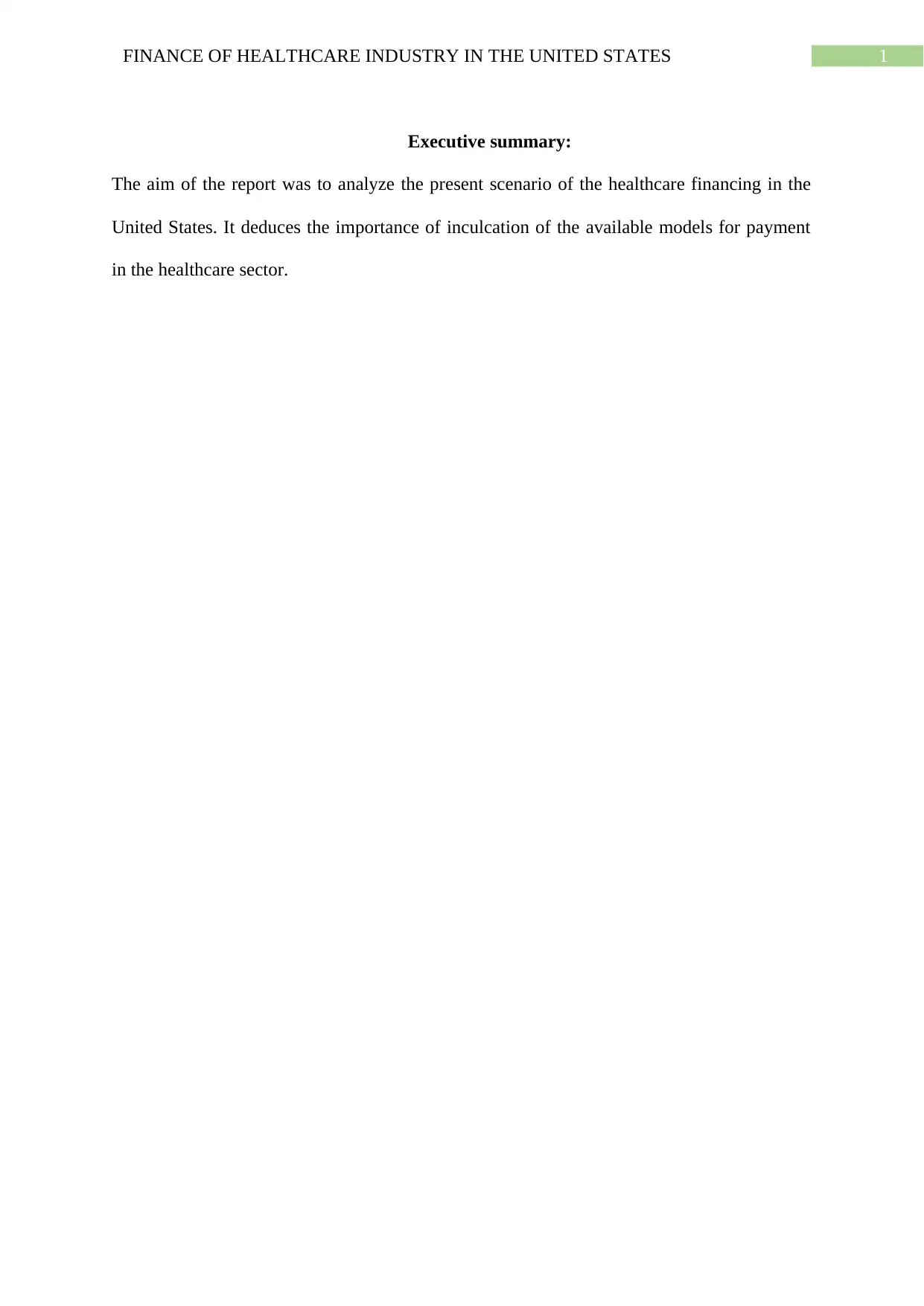
1FINANCE OF HEALTHCARE INDUSTRY IN THE UNITED STATES
Executive summary:
The aim of the report was to analyze the present scenario of the healthcare financing in the
United States. It deduces the importance of inculcation of the available models for payment
in the healthcare sector.
Executive summary:
The aim of the report was to analyze the present scenario of the healthcare financing in the
United States. It deduces the importance of inculcation of the available models for payment
in the healthcare sector.
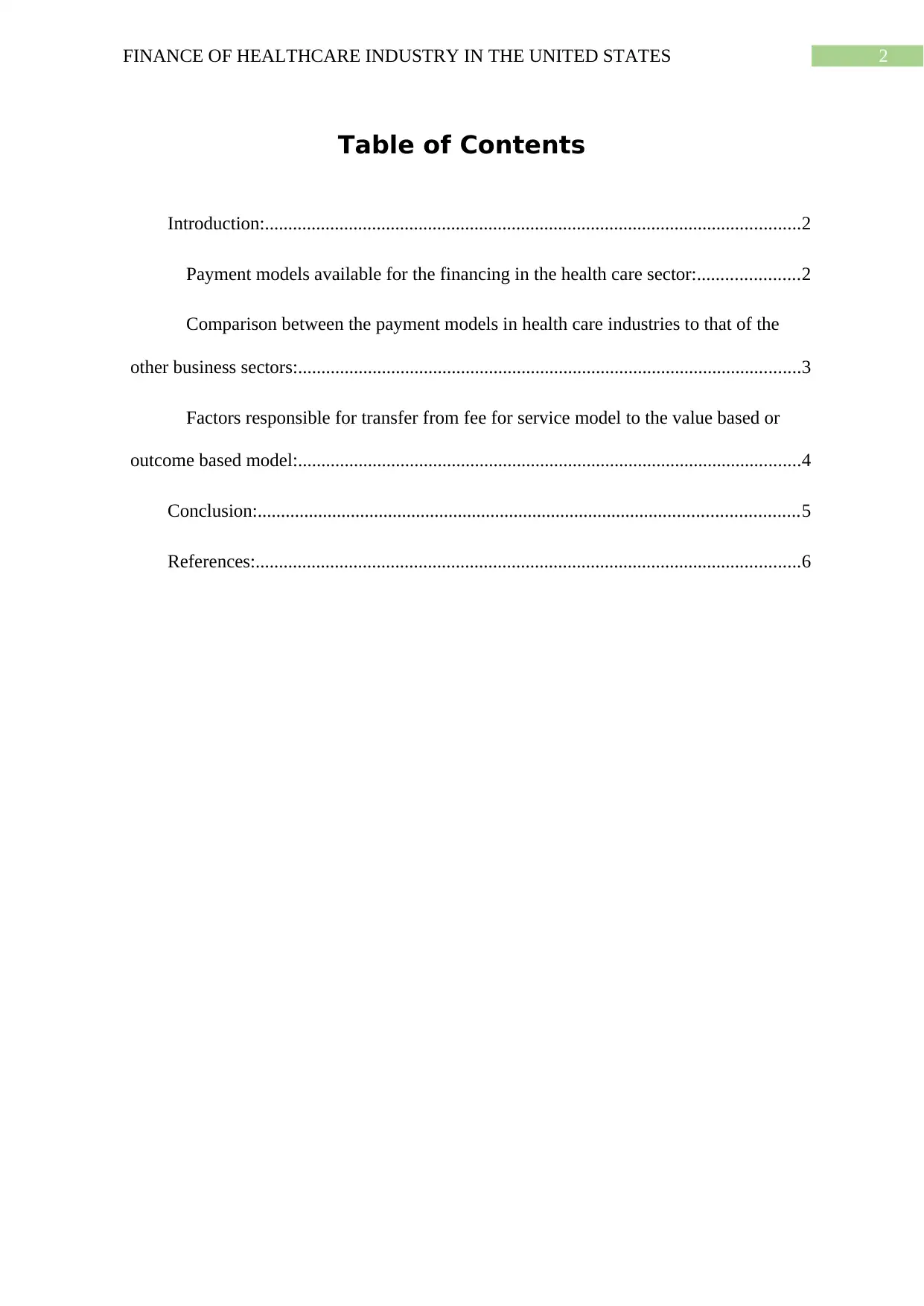
2FINANCE OF HEALTHCARE INDUSTRY IN THE UNITED STATES
Table of Contents
Introduction:...................................................................................................................2
Payment models available for the financing in the health care sector:......................2
Comparison between the payment models in health care industries to that of the
other business sectors:............................................................................................................3
Factors responsible for transfer from fee for service model to the value based or
outcome based model:............................................................................................................4
Conclusion:....................................................................................................................5
References:.....................................................................................................................6
Table of Contents
Introduction:...................................................................................................................2
Payment models available for the financing in the health care sector:......................2
Comparison between the payment models in health care industries to that of the
other business sectors:............................................................................................................3
Factors responsible for transfer from fee for service model to the value based or
outcome based model:............................................................................................................4
Conclusion:....................................................................................................................5
References:.....................................................................................................................6
⊘ This is a preview!⊘
Do you want full access?
Subscribe today to unlock all pages.

Trusted by 1+ million students worldwide
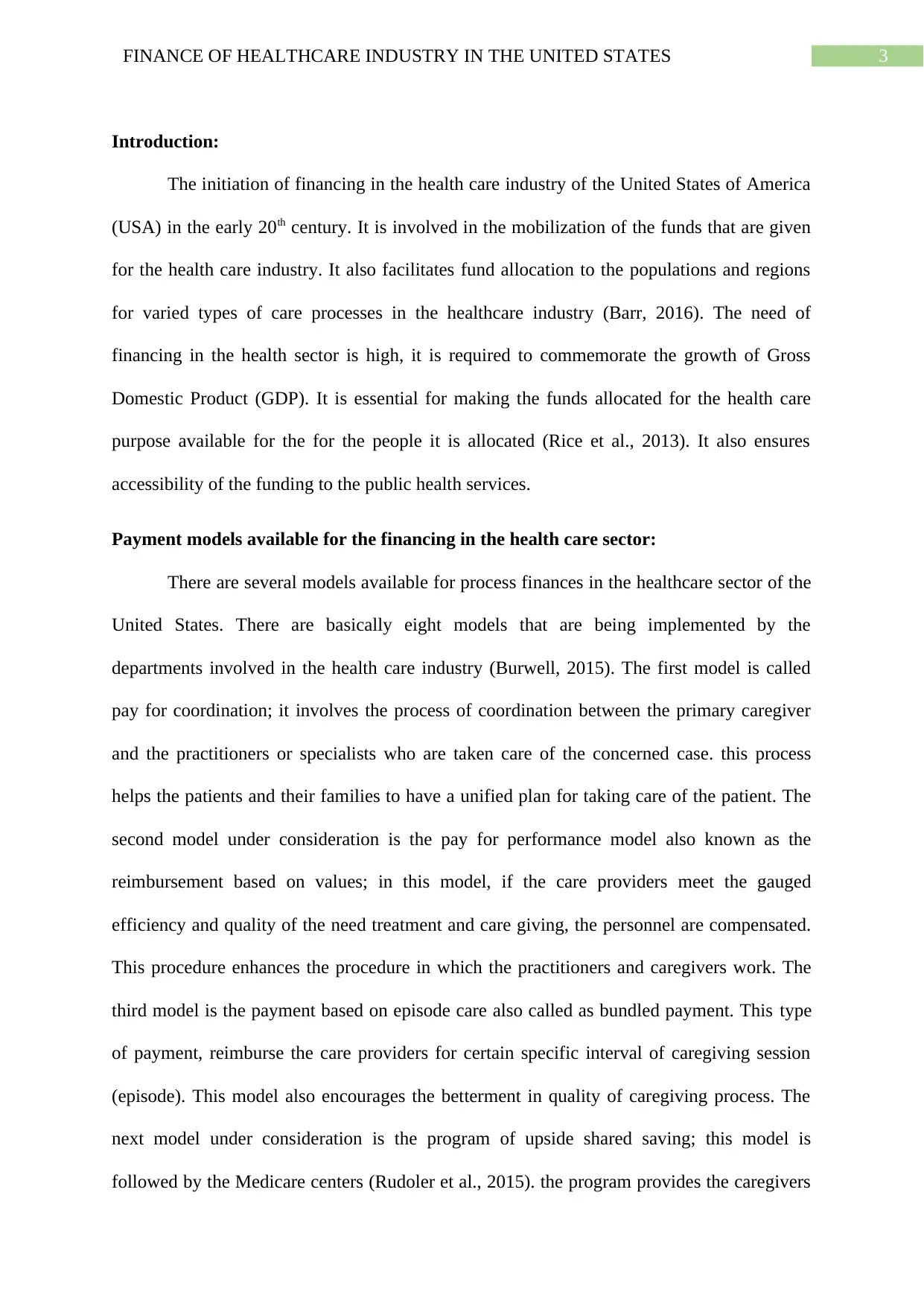
3FINANCE OF HEALTHCARE INDUSTRY IN THE UNITED STATES
Introduction:
The initiation of financing in the health care industry of the United States of America
(USA) in the early 20th century. It is involved in the mobilization of the funds that are given
for the health care industry. It also facilitates fund allocation to the populations and regions
for varied types of care processes in the healthcare industry (Barr, 2016). The need of
financing in the health sector is high, it is required to commemorate the growth of Gross
Domestic Product (GDP). It is essential for making the funds allocated for the health care
purpose available for the for the people it is allocated (Rice et al., 2013). It also ensures
accessibility of the funding to the public health services.
Payment models available for the financing in the health care sector:
There are several models available for process finances in the healthcare sector of the
United States. There are basically eight models that are being implemented by the
departments involved in the health care industry (Burwell, 2015). The first model is called
pay for coordination; it involves the process of coordination between the primary caregiver
and the practitioners or specialists who are taken care of the concerned case. this process
helps the patients and their families to have a unified plan for taking care of the patient. The
second model under consideration is the pay for performance model also known as the
reimbursement based on values; in this model, if the care providers meet the gauged
efficiency and quality of the need treatment and care giving, the personnel are compensated.
This procedure enhances the procedure in which the practitioners and caregivers work. The
third model is the payment based on episode care also called as bundled payment. This type
of payment, reimburse the care providers for certain specific interval of caregiving session
(episode). This model also encourages the betterment in quality of caregiving process. The
next model under consideration is the program of upside shared saving; this model is
followed by the Medicare centers (Rudoler et al., 2015). the program provides the caregivers
Introduction:
The initiation of financing in the health care industry of the United States of America
(USA) in the early 20th century. It is involved in the mobilization of the funds that are given
for the health care industry. It also facilitates fund allocation to the populations and regions
for varied types of care processes in the healthcare industry (Barr, 2016). The need of
financing in the health sector is high, it is required to commemorate the growth of Gross
Domestic Product (GDP). It is essential for making the funds allocated for the health care
purpose available for the for the people it is allocated (Rice et al., 2013). It also ensures
accessibility of the funding to the public health services.
Payment models available for the financing in the health care sector:
There are several models available for process finances in the healthcare sector of the
United States. There are basically eight models that are being implemented by the
departments involved in the health care industry (Burwell, 2015). The first model is called
pay for coordination; it involves the process of coordination between the primary caregiver
and the practitioners or specialists who are taken care of the concerned case. this process
helps the patients and their families to have a unified plan for taking care of the patient. The
second model under consideration is the pay for performance model also known as the
reimbursement based on values; in this model, if the care providers meet the gauged
efficiency and quality of the need treatment and care giving, the personnel are compensated.
This procedure enhances the procedure in which the practitioners and caregivers work. The
third model is the payment based on episode care also called as bundled payment. This type
of payment, reimburse the care providers for certain specific interval of caregiving session
(episode). This model also encourages the betterment in quality of caregiving process. The
next model under consideration is the program of upside shared saving; this model is
followed by the Medicare centers (Rudoler et al., 2015). the program provides the caregivers
Paraphrase This Document
Need a fresh take? Get an instant paraphrase of this document with our AI Paraphraser
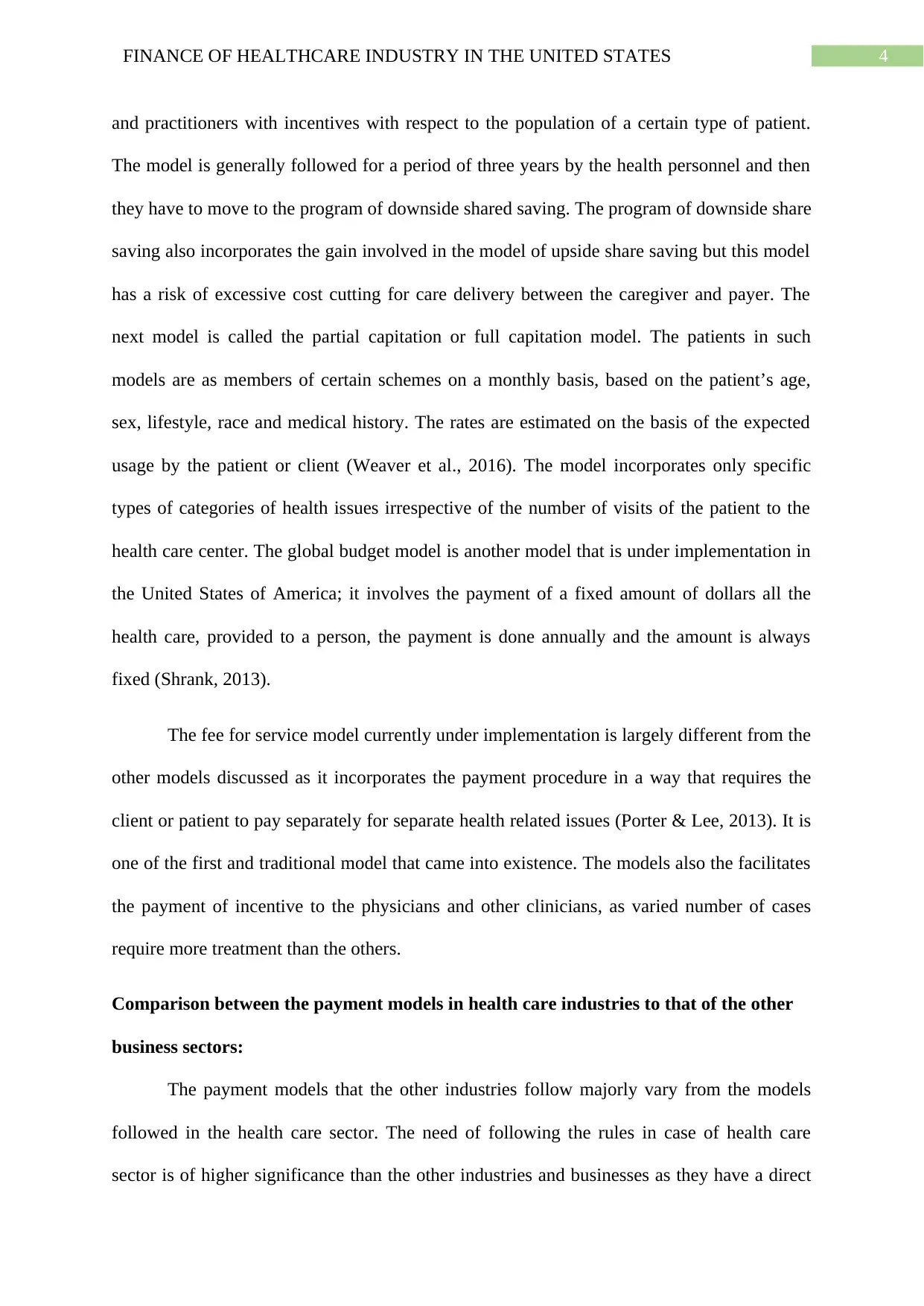
4FINANCE OF HEALTHCARE INDUSTRY IN THE UNITED STATES
and practitioners with incentives with respect to the population of a certain type of patient.
The model is generally followed for a period of three years by the health personnel and then
they have to move to the program of downside shared saving. The program of downside share
saving also incorporates the gain involved in the model of upside share saving but this model
has a risk of excessive cost cutting for care delivery between the caregiver and payer. The
next model is called the partial capitation or full capitation model. The patients in such
models are as members of certain schemes on a monthly basis, based on the patient’s age,
sex, lifestyle, race and medical history. The rates are estimated on the basis of the expected
usage by the patient or client (Weaver et al., 2016). The model incorporates only specific
types of categories of health issues irrespective of the number of visits of the patient to the
health care center. The global budget model is another model that is under implementation in
the United States of America; it involves the payment of a fixed amount of dollars all the
health care, provided to a person, the payment is done annually and the amount is always
fixed (Shrank, 2013).
The fee for service model currently under implementation is largely different from the
other models discussed as it incorporates the payment procedure in a way that requires the
client or patient to pay separately for separate health related issues (Porter & Lee, 2013). It is
one of the first and traditional model that came into existence. The models also the facilitates
the payment of incentive to the physicians and other clinicians, as varied number of cases
require more treatment than the others.
Comparison between the payment models in health care industries to that of the other
business sectors:
The payment models that the other industries follow majorly vary from the models
followed in the health care sector. The need of following the rules in case of health care
sector is of higher significance than the other industries and businesses as they have a direct
and practitioners with incentives with respect to the population of a certain type of patient.
The model is generally followed for a period of three years by the health personnel and then
they have to move to the program of downside shared saving. The program of downside share
saving also incorporates the gain involved in the model of upside share saving but this model
has a risk of excessive cost cutting for care delivery between the caregiver and payer. The
next model is called the partial capitation or full capitation model. The patients in such
models are as members of certain schemes on a monthly basis, based on the patient’s age,
sex, lifestyle, race and medical history. The rates are estimated on the basis of the expected
usage by the patient or client (Weaver et al., 2016). The model incorporates only specific
types of categories of health issues irrespective of the number of visits of the patient to the
health care center. The global budget model is another model that is under implementation in
the United States of America; it involves the payment of a fixed amount of dollars all the
health care, provided to a person, the payment is done annually and the amount is always
fixed (Shrank, 2013).
The fee for service model currently under implementation is largely different from the
other models discussed as it incorporates the payment procedure in a way that requires the
client or patient to pay separately for separate health related issues (Porter & Lee, 2013). It is
one of the first and traditional model that came into existence. The models also the facilitates
the payment of incentive to the physicians and other clinicians, as varied number of cases
require more treatment than the others.
Comparison between the payment models in health care industries to that of the other
business sectors:
The payment models that the other industries follow majorly vary from the models
followed in the health care sector. The need of following the rules in case of health care
sector is of higher significance than the other industries and businesses as they have a direct
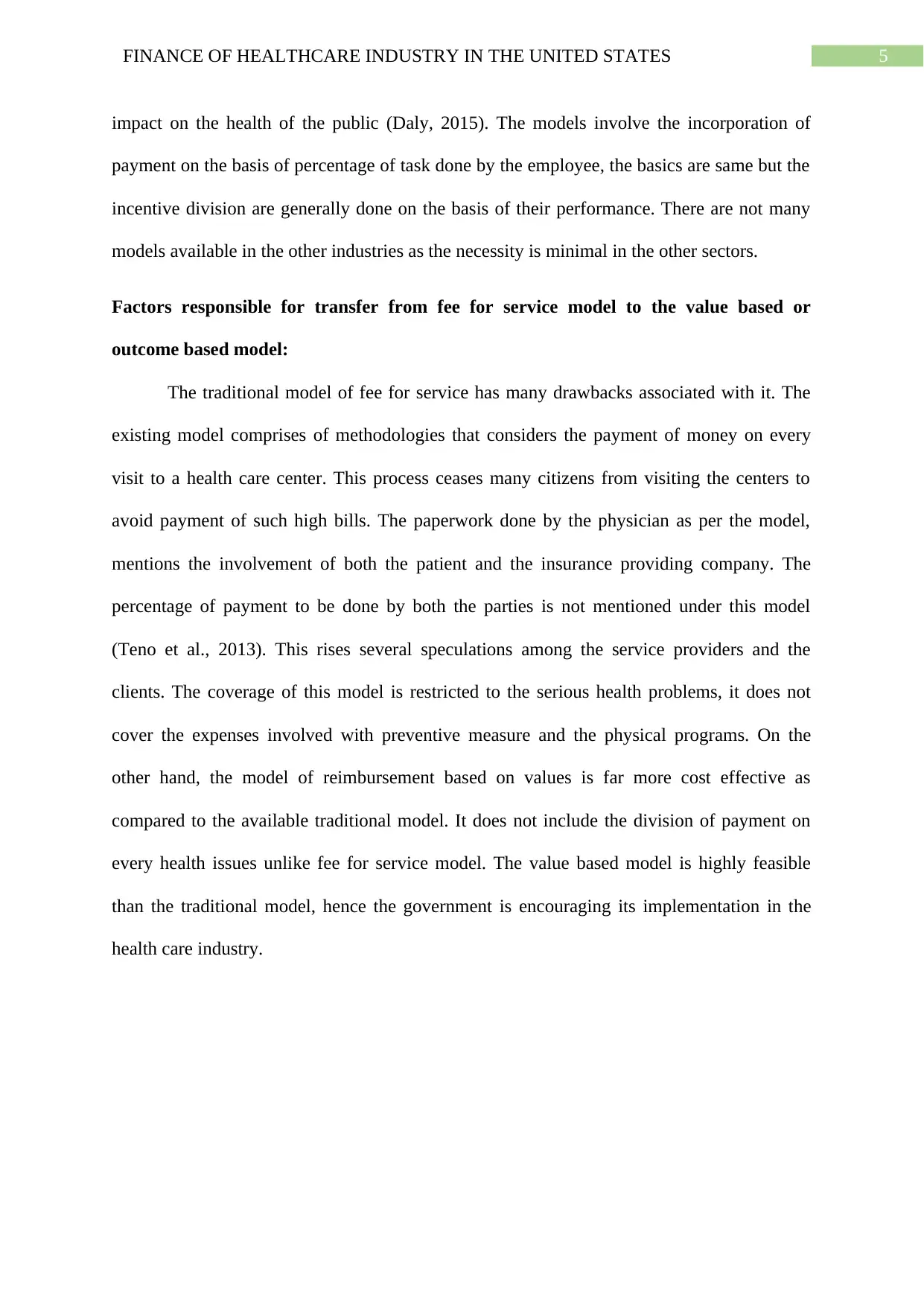
5FINANCE OF HEALTHCARE INDUSTRY IN THE UNITED STATES
impact on the health of the public (Daly, 2015). The models involve the incorporation of
payment on the basis of percentage of task done by the employee, the basics are same but the
incentive division are generally done on the basis of their performance. There are not many
models available in the other industries as the necessity is minimal in the other sectors.
Factors responsible for transfer from fee for service model to the value based or
outcome based model:
The traditional model of fee for service has many drawbacks associated with it. The
existing model comprises of methodologies that considers the payment of money on every
visit to a health care center. This process ceases many citizens from visiting the centers to
avoid payment of such high bills. The paperwork done by the physician as per the model,
mentions the involvement of both the patient and the insurance providing company. The
percentage of payment to be done by both the parties is not mentioned under this model
(Teno et al., 2013). This rises several speculations among the service providers and the
clients. The coverage of this model is restricted to the serious health problems, it does not
cover the expenses involved with preventive measure and the physical programs. On the
other hand, the model of reimbursement based on values is far more cost effective as
compared to the available traditional model. It does not include the division of payment on
every health issues unlike fee for service model. The value based model is highly feasible
than the traditional model, hence the government is encouraging its implementation in the
health care industry.
impact on the health of the public (Daly, 2015). The models involve the incorporation of
payment on the basis of percentage of task done by the employee, the basics are same but the
incentive division are generally done on the basis of their performance. There are not many
models available in the other industries as the necessity is minimal in the other sectors.
Factors responsible for transfer from fee for service model to the value based or
outcome based model:
The traditional model of fee for service has many drawbacks associated with it. The
existing model comprises of methodologies that considers the payment of money on every
visit to a health care center. This process ceases many citizens from visiting the centers to
avoid payment of such high bills. The paperwork done by the physician as per the model,
mentions the involvement of both the patient and the insurance providing company. The
percentage of payment to be done by both the parties is not mentioned under this model
(Teno et al., 2013). This rises several speculations among the service providers and the
clients. The coverage of this model is restricted to the serious health problems, it does not
cover the expenses involved with preventive measure and the physical programs. On the
other hand, the model of reimbursement based on values is far more cost effective as
compared to the available traditional model. It does not include the division of payment on
every health issues unlike fee for service model. The value based model is highly feasible
than the traditional model, hence the government is encouraging its implementation in the
health care industry.
⊘ This is a preview!⊘
Do you want full access?
Subscribe today to unlock all pages.

Trusted by 1+ million students worldwide
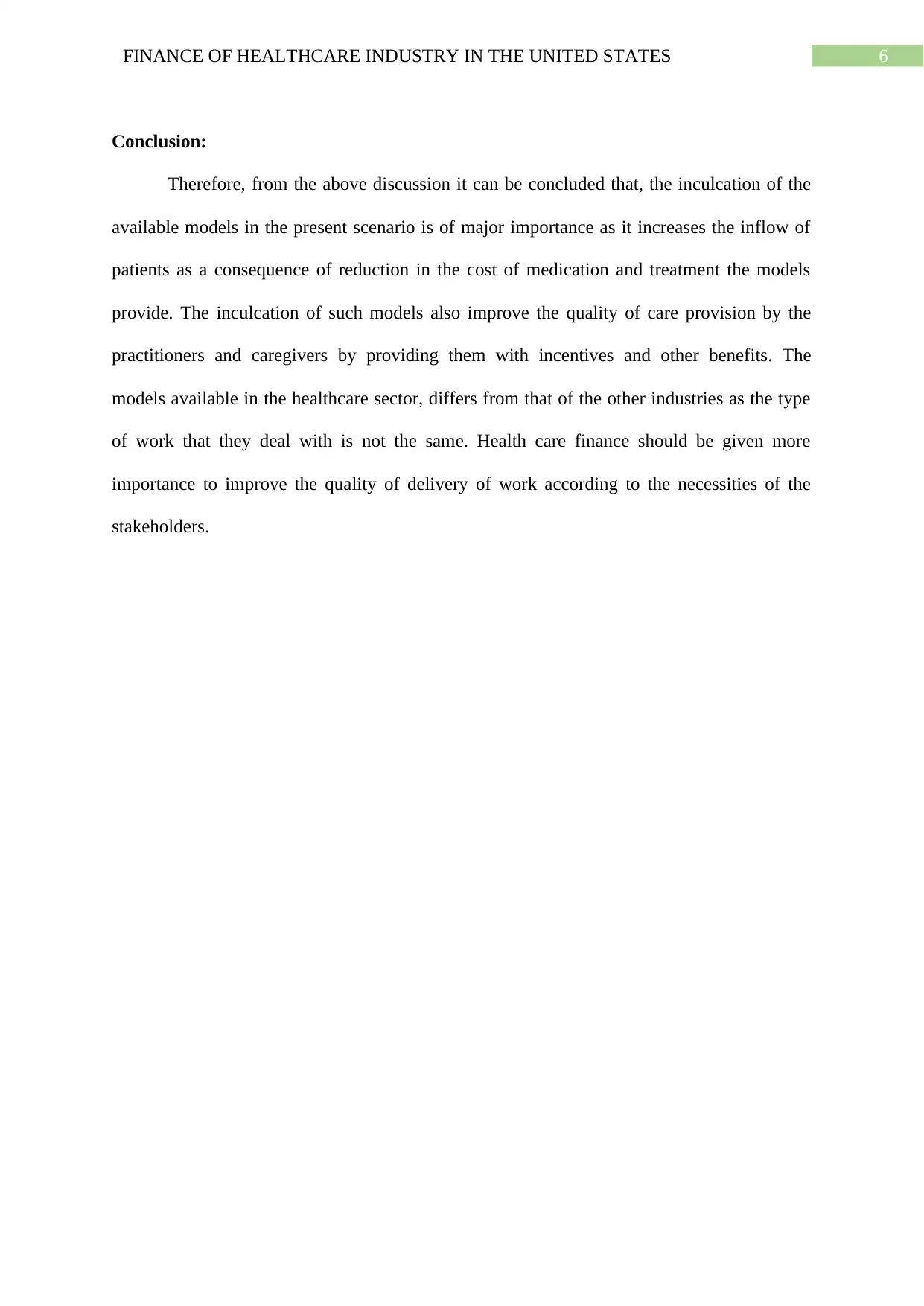
6FINANCE OF HEALTHCARE INDUSTRY IN THE UNITED STATES
Conclusion:
Therefore, from the above discussion it can be concluded that, the inculcation of the
available models in the present scenario is of major importance as it increases the inflow of
patients as a consequence of reduction in the cost of medication and treatment the models
provide. The inculcation of such models also improve the quality of care provision by the
practitioners and caregivers by providing them with incentives and other benefits. The
models available in the healthcare sector, differs from that of the other industries as the type
of work that they deal with is not the same. Health care finance should be given more
importance to improve the quality of delivery of work according to the necessities of the
stakeholders.
Conclusion:
Therefore, from the above discussion it can be concluded that, the inculcation of the
available models in the present scenario is of major importance as it increases the inflow of
patients as a consequence of reduction in the cost of medication and treatment the models
provide. The inculcation of such models also improve the quality of care provision by the
practitioners and caregivers by providing them with incentives and other benefits. The
models available in the healthcare sector, differs from that of the other industries as the type
of work that they deal with is not the same. Health care finance should be given more
importance to improve the quality of delivery of work according to the necessities of the
stakeholders.
Paraphrase This Document
Need a fresh take? Get an instant paraphrase of this document with our AI Paraphraser
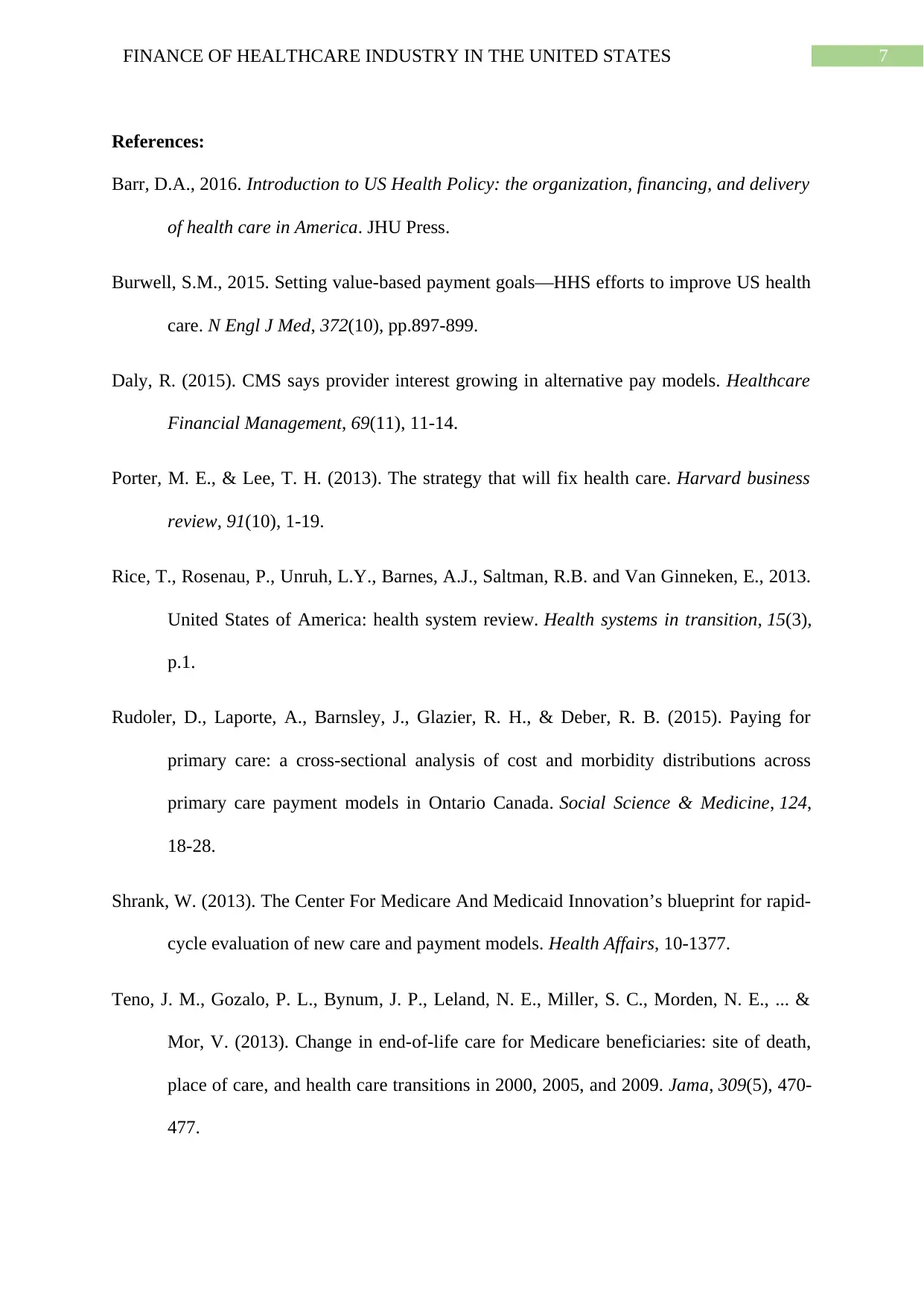
7FINANCE OF HEALTHCARE INDUSTRY IN THE UNITED STATES
References:
Barr, D.A., 2016. Introduction to US Health Policy: the organization, financing, and delivery
of health care in America. JHU Press.
Burwell, S.M., 2015. Setting value-based payment goals—HHS efforts to improve US health
care. N Engl J Med, 372(10), pp.897-899.
Daly, R. (2015). CMS says provider interest growing in alternative pay models. Healthcare
Financial Management, 69(11), 11-14.
Porter, M. E., & Lee, T. H. (2013). The strategy that will fix health care. Harvard business
review, 91(10), 1-19.
Rice, T., Rosenau, P., Unruh, L.Y., Barnes, A.J., Saltman, R.B. and Van Ginneken, E., 2013.
United States of America: health system review. Health systems in transition, 15(3),
p.1.
Rudoler, D., Laporte, A., Barnsley, J., Glazier, R. H., & Deber, R. B. (2015). Paying for
primary care: a cross-sectional analysis of cost and morbidity distributions across
primary care payment models in Ontario Canada. Social Science & Medicine, 124,
18-28.
Shrank, W. (2013). The Center For Medicare And Medicaid Innovation’s blueprint for rapid-
cycle evaluation of new care and payment models. Health Affairs, 10-1377.
Teno, J. M., Gozalo, P. L., Bynum, J. P., Leland, N. E., Miller, S. C., Morden, N. E., ... &
Mor, V. (2013). Change in end-of-life care for Medicare beneficiaries: site of death,
place of care, and health care transitions in 2000, 2005, and 2009. Jama, 309(5), 470-
477.
References:
Barr, D.A., 2016. Introduction to US Health Policy: the organization, financing, and delivery
of health care in America. JHU Press.
Burwell, S.M., 2015. Setting value-based payment goals—HHS efforts to improve US health
care. N Engl J Med, 372(10), pp.897-899.
Daly, R. (2015). CMS says provider interest growing in alternative pay models. Healthcare
Financial Management, 69(11), 11-14.
Porter, M. E., & Lee, T. H. (2013). The strategy that will fix health care. Harvard business
review, 91(10), 1-19.
Rice, T., Rosenau, P., Unruh, L.Y., Barnes, A.J., Saltman, R.B. and Van Ginneken, E., 2013.
United States of America: health system review. Health systems in transition, 15(3),
p.1.
Rudoler, D., Laporte, A., Barnsley, J., Glazier, R. H., & Deber, R. B. (2015). Paying for
primary care: a cross-sectional analysis of cost and morbidity distributions across
primary care payment models in Ontario Canada. Social Science & Medicine, 124,
18-28.
Shrank, W. (2013). The Center For Medicare And Medicaid Innovation’s blueprint for rapid-
cycle evaluation of new care and payment models. Health Affairs, 10-1377.
Teno, J. M., Gozalo, P. L., Bynum, J. P., Leland, N. E., Miller, S. C., Morden, N. E., ... &
Mor, V. (2013). Change in end-of-life care for Medicare beneficiaries: site of death,
place of care, and health care transitions in 2000, 2005, and 2009. Jama, 309(5), 470-
477.
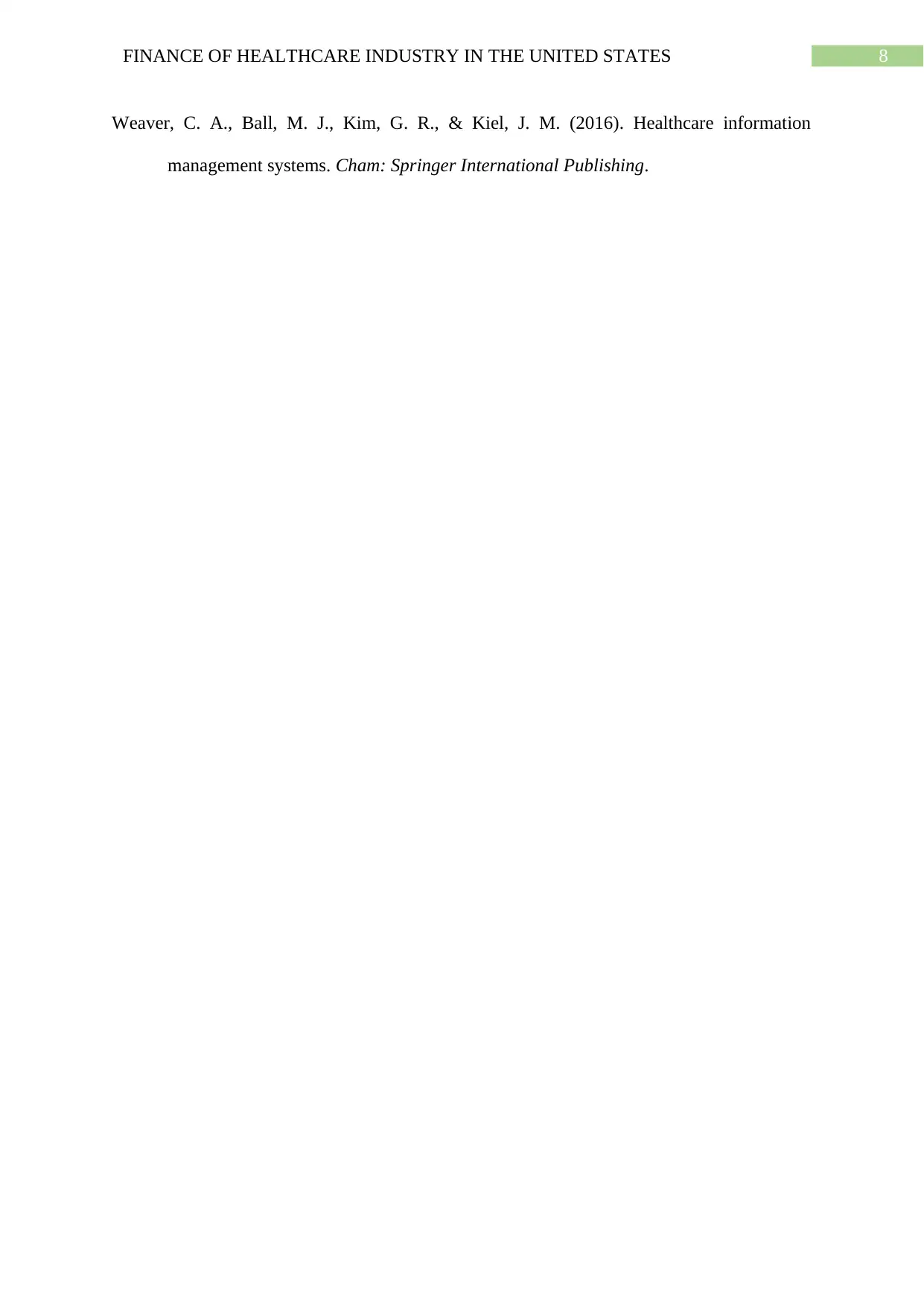
8FINANCE OF HEALTHCARE INDUSTRY IN THE UNITED STATES
Weaver, C. A., Ball, M. J., Kim, G. R., & Kiel, J. M. (2016). Healthcare information
management systems. Cham: Springer International Publishing.
Weaver, C. A., Ball, M. J., Kim, G. R., & Kiel, J. M. (2016). Healthcare information
management systems. Cham: Springer International Publishing.
⊘ This is a preview!⊘
Do you want full access?
Subscribe today to unlock all pages.

Trusted by 1+ million students worldwide
1 out of 9
Related Documents
Your All-in-One AI-Powered Toolkit for Academic Success.
+13062052269
info@desklib.com
Available 24*7 on WhatsApp / Email
![[object Object]](/_next/static/media/star-bottom.7253800d.svg)
Unlock your academic potential
Copyright © 2020–2025 A2Z Services. All Rights Reserved. Developed and managed by ZUCOL.





